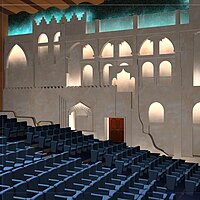
Qatar observes several public holidays. The two weekend days are Friday and Saturday, similarly to other Islamic countries. Annual public holidays include:

The music of Qatar is based on sea folk poetry, song and dance. The historical importance of pearl fishing have deeply resonated within the region's artistic expression, manifesting in melodies, tunes, and dances that reflect the enduring bond between humanity and the sea. Traditional dances in Doha are performed on Friday afternoons; one such dance is the Ardah, a stylized martial dance performed by two rows of dancers who are accompanied by an array of percussion instruments, including al-ras, mirwas and cymbals with small drums. Other folk instruments include the oud and rebaba, both string instruments, as well as the ney and sirttai, which are types of flutes.

The Consultative Assembly is the legislative body of the State of Qatar, with 45 members. Following the 2021 Qatari general election, it has 30 elected and 15 appointed members. The body can only question the prime minister, who is appointed by the Emir of Qatar, on his policies if two-thirds of the members agree, which is unlikely given that one-third of the members are appointed by the Emir.

Abdulla Bin Zaid Al Mahmoud Islamic Cultural Center is a cultural organization in Doha, the capital of Qatar. It is located close to Doha Corniche and is a prominent landmark in the city.

Qatar is a Muslim-majority country with Islam as the state religion. Salafi version of Islam is the state sponsored brand of Sunni Islam in the country, making Qatar one of the two Salafi states in the Muslim world, along with Saudi Arabia.

The following outline is provided as an overview of and topical guide to Qatar:

Al Khor is a coastal city in northeast Qatar, located 50 kilometres (31 mi) north of the capital Doha. Considered one of Qatar's largest cities, it is the capital city of the municipality of Al Khor and Al Thakhira. Dating back to the 18th century, it is one of Qatar's oldest settlements. The name of the city, meaning creek in Arabic, emerged because the original settlement was built on a creek. Until the mid-1900s, it was known as Khor Al Shaqiq.

The culture of Qatar is strongly influenced by traditional Bedouin culture, with less acute influence deriving from India, East Africa, and elsewhere in the Persian Gulf. The peninsula's harsh climate has historically shaped the lifestyle of its inhabitants, driving a reliance on the sea for sustenance and fostering a distinct emphasis on maritime activities within local culture. Arts and literature themes are often related to sea-based activities. Qatari folklore and music best enshrine the state's marine tradition, with pearling trips serving as the main inspiration for music and traditional Qatari myths like May and Ghilân being centered around the sea.

Doha is the capital city and main financial hub of Qatar. Located on the Persian Gulf coast in the east of the country, north of Al Wakrah and south of Al Khor, it is home to most of the country's population. It is also Qatar's fastest growing city, with over 80% of the nation's population living in Doha or its surrounding suburbs, known collectively as the Doha Metropolitan Area.

Qatar Museums is a Qatari government entity that oversees the Museum of Islamic Art (MIA), Mathaf: Arab Museum of Modern Art, MIA Park, QM Gallery at the Katara Cultural Village, ALRIWAQ DOHA Exhibition Space, the Al Zubarah World Heritage Site Visitor Centre, and archaeological projects throughout Qatar, as well as the development of future projects and museums that will highlight its collections across multiple areas of activity including Orientalist art, photography, sports, children's education, and wildlife conservation.

Women's rights in Qatar are restricted by the country's male guardianship law - currently the only remaining country in the Gulf region with such laws - and influenced by the Wahhabi interpretation of Islam. Both women and men were enfranchised in the country at the same time. Labour force participation rates of Qatari women are above the world average and among the highest in the Arab World, which comes mainly as a result of an increasing number of Qatari women who are attaining academic degrees.

The mass media in Qatar relays information and data in Qatar by means of television, radio, cinema, newspapers, magazines and the internet. Qatar has established itself as a leading regional figure in mass media over the past decade. Al Jazeera, a global news network which was established in 1996, has become the foundation of the media sector. The country uses media to brand itself and raise its international profile.

Qatar National Theater is located on the Doha Corniche, near Al Rumaila Garden in Doha, Qatar. The 490-seat theatre opened in 1986 and hosts concerts and plays. In addition to hosting local troupes, it also hosts international and Arab theatrical troupes on occasion.

The modern Qatari art movement emerged in the mid-20th century, as a result of the new-found wealth acquired from oil exports and the subsequent modernization of Qatari society. Because of Islam's non-inclusive stance of depictions of sentient beings in visual arts, paintings historically played an insignificant role in the country's culture. Other visual art forms such as calligraphy, architecture, and textiles were more highly regarded in the Bedouin tradition.

Qatari literature traces its origins back to the 19th century. Originally, written poetry was the most common form of expression, but poetry later fell out of favor after Qatar began reaping the profits from oil exports in the mid-20th century and many Qataris abandoned their Bedouin traditions in favor of more urban lifestyles.

Qatari folklore largely revolves around sea-based activities and the accolades of renowned folk heroes. Like elsewhere on the Arabian Peninsula, folktales – known in Qatar as hazzawi – play an important role in Qatar's culture. Some of Qatar's folktales have a distinctive local character while others have been imparted by nomadic tribes wandering between the present-day Arab states of the Persian Gulf. Local folk stories were seldom documented, instead being passed down orally from generation to generation. After Qatar began profiting from oil exploration, the tradition of passing down these stories gradually ceased. Government ministries such as the Ministry of Culture and Sports and local universities have made efforts to preserve and transcribe local legends in publications.

Cinema in Qatar is a relatively young industry that evolved as part of the country’s plans to develop different local sectors with the aim of accumulating international recognition and status. Many major steps were taken to implement a long-term plan to develop the infrastructure as well as giving opportunities to local talents to have a platform that establishes their presence within the film industry with the support of the Doha Film Institute, and their various grants, workshops and festivals. The Qatar National Vision 2030 has three major pillars to development: human, social economic and environmental; this vision provides frameworks that enable the development of different elements within Qatar and its society; one of which is the high importance put on developing and cultivating artistic talents to represent and define Qatar on a global scale. Another important element in developing the movie industry is the influence and vision of Sheikha Al Mayassa who founded Doha Film Institution; the establishment of film as a mode of storytelling was imperative because it serves the purpose of granting Qatar a global presence through the talents that are supported and cultivated because of her initiative. The film industry plays a role in amplifying the Qatari national identity alongside the identity of the Arab world as a whole.
Hessa or Hissa Al-Awadi is a Qatari poet and short story writer.
May and Gilan is a legend, or hikâya, originating from Qatar. In Qatari folklore, the tale of May and Ghilân has been celebrated as a foundational narrative, often recounted through oral tradition. Ghilân, a prominent figure in Qatar's maritime history, is revered as the progenitor of pearl fishing, the historical mainstay of Qatar's inhabitants.













